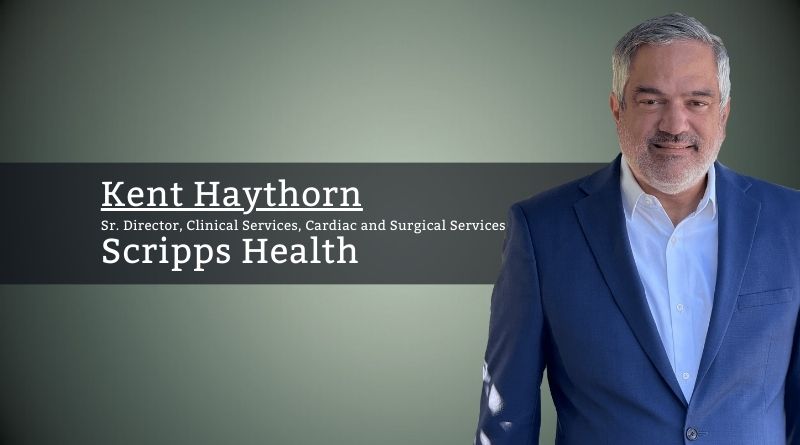Technologies Transforming the Surgical Experience
By Kent Haythorn, Senior Director, Clinical Services, Cardiac and Surgical Services, Scripps Health
The opportunities for integrating technology into the surgical space are leading the way toward better efficiency, quality, and patient care. Innovations are the machine that drives organizations toward value and decreased waste. Minimally invasive surgery has advanced from laparoscopic interventions to even better modalities that decrease pain, hospital length of stay, and efficiency. Robotic-assisted surgery is one of the most significant advancements over the past several years. I was fortunate to be exposed to the first Davinci surgical robot system in the early 2000s while working for a hospital in Rochester, New York. It was difficult to make decisions about the best use for the robot- it was the early adoption and learning curve. Ultimately, the Davinci found its place in urology. Later in my career, while working at the Washington D.C., I saw this become the standard of care for prostate surgery. In 2014, I worked with senior leadership at a large hospital system to upgrade the entire fleet of 9 robots to the current Xi model. Robotic surgery not only can improve surgeon precision, but it also has very favorable outcomes for patients – less blood loss, pain and recovery time.
One of the most exciting advances in robotic surgery is in the cardiac surgery space. Today, we are able to do mitral valve surgery using the Davinci robot and continue to explore in other disciplines. The most recent technology from Intuitive is the Davinci single port robot that allows for a single incision and a far less invasive surgery. I am currently exploring the use of this innovative surgical approach with one of our world-renowned robotic surgeons who want to use it in prostate surgery.
Another fascinating technological innovation we have employed at a San Diego hospital is Aquablation. Developed in 2015, Aquablation is fundinding it way into operating rooms around the country, and we are one of 20 training sites in the United States. It uses a heat-free water jet controlled by robotic technology combined with a cystoscope to remove prostate tissue. The ultrasound imaging gives the surgeon the opportunity to visualize the entire prostate while the surgery is underway. Aquablation therapy is characterized by precision and reliable predictability. Another unique characteristic is that this device can manage any size prostate.
There will always be a human component to surgical services that supports innovation and creative thinking.
Our patients tell us they are very pleased with the Aquablation procedure. They indicate minimal pain and great overall outcomes. What is unique about this device is that it has two phases. The first phase is the mapping to understand the size and shape of the prostate. That allows for greater precision in identifying abnormalities in the prostate. The second phase involves engaging a robotic, heat-free water jet that removes the prostate tissue. The combination produces a favorable outcome and has become the treatment of choice for Benign Prostate Hypertrophy (BPH).
Still, another exciting technology we currently use in our operating rooms is the robotic-assisted arm for total joint surgeries. We use the CORI robotic-assisted Arthroplasty system. The CORI system supports surgeons by better mapping of the knee without CT or MRI. It is also helpful in identifying proper implants, providing intraoperative visualization for maintaining healthy joint lines and identifying areas for bone removal. This robot provides the surgeon and the patient with a personalized approach to care delivery. We use CORI most often in our total joint revisions.
Finally, no article on technology in surgery would be complete without discussing the integration of Electronic Medical Records (EMR) into the operating room. EMR has changed everything about the way we do business – from scheduling all the way to discharge. I have been a surgery leader for over 20 years and have worked with several systems. What has always been a challenge for both the vendors and leaders is successfully designing systems that capture data and then transferring it into valuable business intelligence platforms that assist leaders in decision-making and business analytics. It has improved remarkably, but there are still opportunities to grow and improve in this space.
One thing we are currently doing in our operating rooms at my current hospital is changing the way we do charge capture and preference card management. Instead of using a “charge by exception” model to capture supply costs in the operating room, we are moving to a 100% capture by scanners. This change has a projected savings of $300,000 for the system. It does require strong and effective leadership and careful process design, but it is well worth the effort. We also instituted a process where changes in preference cards were made at the point of service. This has improved the quality of the cards and cases are better prepared.
The future of technology in the operating room is bright and exciting. I think we will soon (if not already) be printing custom 3D implants in the operating room that are customized to individual patient needs. It appears that AI may provide opportunities to improve scheduling, operating room efficiency, and predictive analysis for post-operative complications. I have not yet participated in the space, but I am excited to do so. Finally, I want to recognize the most important technological components in all areas of surgical services. These are the surgeons, nurses, surgical technicians, and other support staff who come to work every day and assist in using these innovative technologies. I am proud of my role in surgical services and as a provider of the teams I serve. There will always be a human component to surgical services that supports innovation and creative thinking.



